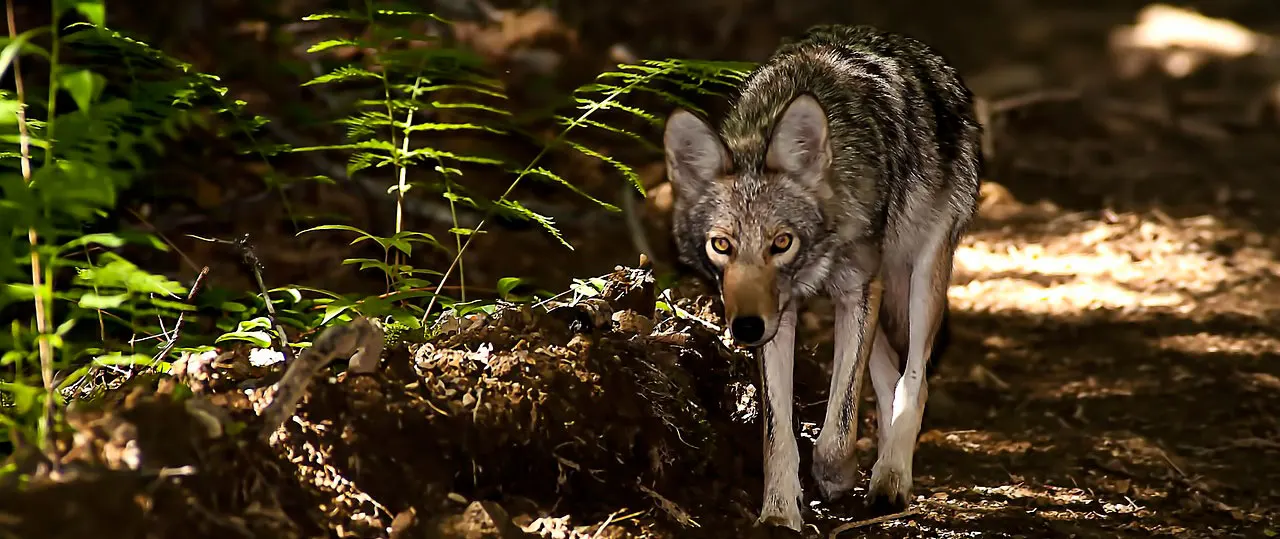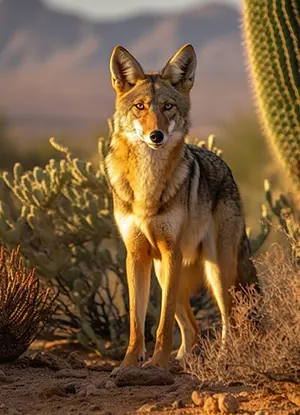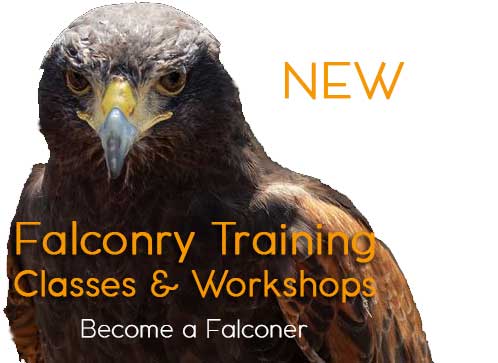Are coyotes dangerous to humans? In short - yes. Coyotes are dangerous for humans and domesticated pets alike and encounters should be avoided at all cost.

Understanding Coyote Behavior: Are Coyotes Dangerous?
Natural Coyote Habitat
In Canada, the coyote is found just about everywhere but the arctic. While it's original home was the Prairies, its presence has expanded to the Boreal Forest, the mountains, and Atlantic Canada. The coyote has also moved into more urban evironments, making human encounters near unavoidable. The reasons for such migration or expansion include loss of habitat due to human structures and development as well as the aggressive hunting and near extinction of wolves in some areas. Wolves and coyotes will rarely occupy the same territory.
Natural Coyote Diet
Although primarily a carnivore, the coyote will happily adjust and devour anything available. In the wild, rabbits and hares are dietary staples, along with other small mammals or rodents. In the spring, deer fawn often fall prey to coyotes and in harsh times, even adult deer will attract attention. Coyotes will also consume carrion. To a smaller extent, insects like grasshoppers and various berries and fruit are part of the coyote diet as well. When near human developments, coyotes will prey on livestock, including sheep, beef calves, and poultry
Coyote Social Structure
Much like wolves, coyotes also live in groups, or packs. A pack usually consists of an alpha male and female couple, and a few lower ranking members. In contrast to wolves, coyotes travel and hunt alone but return to the 'family' to rest and sleep. Coyotes are smart, social, and playful animals. In addition to resident packs, there are also solitary coyotes that have left their packs and are looking to join other groups or start one of their own.
Seasonal Changes in Behavior
A common misconception is that when coyotes are out 'n about during the day, they are likely ill. You may see more coyotes out in broad daylight at certain times of the year. Especially during the summer months, they need to forage more frequently to feed young ones in their den.
Coyote Encounters with Humans: When Are Coyotes Dangerous?
When are coyotes dangerous? Coyotes will become more territorial and aggressive during mating season and while parents care for their pups. This is usually between January and June. Pups are born in a den and will remain there for about six weeks. After that, they will go on hunting expeditions with mum and dad and by the end of summer, the den will be abandoned and the youngsters are grown and able to look after themselves.
 Common Reasons for Coyote-Human Interactions
Common Reasons for Coyote-Human Interactions
There was a noticeable surge of coyote sightings during COVID lockdowns due to us humans having largely vacated the outdoors. Coyotes simply moved into the places we seemed to have moved out of. This caused a number of serious indidents, particularly in Burlington, Ontario.
Distinguishing Between Aggressive and Other Behaviors
- Following or Escorting:
Coyotes are highly intelligent and curious creatures, not unlike man's best friend. They may appear to follow hikers, joggers, or cyclists - likely because there's a den with pups nearby and they are surveying and assessing the situation. This is curiosity, not aggression. - Staring:
Ok, this one can feel creepy. A wild animal standing motionless and just watching you would feel pretty uncomfortable. However, not unlike the escorting behavior, this isn’t about being aggressive or bold, but rather about being cautious. You might be close to a den site, a food source and need to be observed to determine whether you may be or become a threat. This is caution, not aggression. - Howling and yipping:
Coyotes vocalize for all sorts of reasons, and certainly not only to announce or celebrate a kill. Coyotes use their howls and yips to communicate with members of the pack (or family) or to let other coyote families know that this is their territory. Additionally, coyotes make a wide array of different sounds, so only two or three can sound like as many as ten! This is communication, not aggression.
Reported Incidents and Statistics
While coyote attacks on humans were relatively rare (about 10 per year), the City of Burlington in particular saw a string of 7 attacks in 2022 alone.
Potential Risks to Humans
When asking yourself: "Are coyotes dangerous to people?", of course, the answer has to be yes. Anytime a predator is encountered in the wild, there is the potential for conflict.
Direct Threats to Personal Safety
The damage a coyote can inflict on a person is similar to what a vicious dog could do. As in several reported cases, coyotes may go after small children, rather than adults - and that thought is terrifying. That said, entirely unprovoked attacks are isolated. There are some do's and dont's we talked about in another article dealing with coyote attacks. At the absolute top of the list is Don't Feed the Animals!
Risks to Pets and Livestock
Occasionally pets on a leash may be the object of an attack, but lifestock falling prey to hungry coyotes is much more likely. This is generally smaller animals, such as sheep, calves, or poultry.
Disease Transmission Concerns
Although fairly rare, coyotes can be carriers of rabies. They are also able to transmit the parvo virus to both, your dog and you. Additionally, they often carry tape worms or canine heart worm, which can be rather serious for your domestic friend.
How Dangerous Are Coyotes? Preventing Coyote Conflicts
As with all wildlife conflicts, let's make sure that we are part of the solution and not the problem.
Securing Your Property
Securing your lifestock buildings is a must. Consider that coyotes can climb and overcome a 6 foot fence rather easily. Ensure that your lifestock housing has some sort of roof structure and preferrably a locking door.
Proper Waste Management
Human trash bins are always attractive to all sorts of wildlife. Coyotes are no different. Additionally, it may not be the trash bins the coyote is after, but the smaller animals frequenting your yard, attracted by the buffet of food scraps or left out pet food.
Pet Safety Measures
If you have had coyote sightings, your dog or cat should not be out in the yard unsupervised, and definitely not be tied. It would be next to impossible to prevent a coyote from coming into your yard. You should contact your municipality and discuss next steps.
Balance Wildlife Conservation and Human Safety with Hawkeye
Despite conflicts with lifestock and humans, the coyote's value as a scavenger and a predator of rodents should not be underestimated. Its role in nature must be appreciated and considered in any evaluation of the animal. Hawkeye Bird & Animal Control has extensive experience with Coyote Control and Removal. Contact us to learn more.














